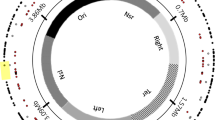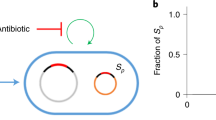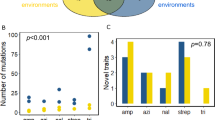Abstract
Strains of the bacterium Escherichia coli habouring genes that increase mutation rates are known to have an evolutionary advantage in chemostat competition over otherwise isogeneic strains with lower mutation rates1–3. This advantage is frequency-dependent, the mutator strain being favoured only above a starting ratio of ∼5×10−5, and it results from the fact that the necessary beneficial mutations cannot be generated in a mutator population below a certain size3. Here we consider the possibility that the mutagenic4,5 properties of transposable elements confer an advantage in the same manner as mutator genes. A previous report has shown that the transposon Tn5 increases the fitness of E. coli in chemostats, although the reason for this effect has not been established6. Our results show that the transposon Tn10 also confers an advantage in chemostats. In addition, we find that (1) this advantage, like that associated with mutator genes, is frequency-dependent, (2) whenever the Tn10 strains win, a segment of Tn10, probably its IS10 sequences, has undergone transposition to a new site, (3) the new insertions converge into a site contained within a 3.2 kilobase (kb) PvuII fragment of the genome, and (4) no transpositions are detected when the Tn10 population lses. We conclude that Tn10 confers an advantage by increasing the mutation rate of the host bacterium.
This is a preview of subscription content, access via your institution
Access options
Subscribe to this journal
Receive 51 print issues and online access
$199.00 per year
only $3.90 per issue
Buy this article
- Purchase on Springer Link
- Instant access to full article PDF
Prices may be subject to local taxes which are calculated during checkout
Similar content being viewed by others
References
Gibson, T. C., Scheppe, M. L. & Cox, E. C. Science 169, 686–688 (1970).
Nestmann, E. R. & Hill, R. F. Genetics 73, 41–44 (1973).
Chao, L. & Cox, E. C. Evolution 37, 125–134 (1983).
Kleckner, N. Cell 11, 11–23 (1977).
Nevers, P. & Saedler, H. Nature 268, 109–115 (1977).
Biel, S. W. & Hartl, D. L. Genetics (in the press).
Foster, T. J., Davis, M. A., Roberts, D. E., Takeshita, K. & Kleckner, N. Cell 23, 201–213 (1981).
Kleckner, N., Roth, J. & Botstein, D. J. molec. Biol. 116, 125–159 (1977).
Miller, J. H. Experiments in Molecular Genetics (Cold Spring Harbor Laboratory, New York, 1972).
Southern, E. M. J. molec. Biol. 98, 503–517 (1975).
Jorgensen, R. A., Berg, D. E., Allet, B. & Reznikoff, W. S. J. Bact. 137, 681–685 (1979).
Ross, D. G., Grisafi, P., Kleckner, N. & Botstein, D. J. Bact. 139, 1097–1101 (1979).
Read, H. A. & Jaskunas, S. R. Molec. gen. Genet. 180, 157–164 (1981).
Doolittle, W. F. & Sapienza, C. Nature 284, 601–603 (1980).
Orgel, L. E. & Crick, F. H. Nature 284, 604–610 (1980).
Maynard Smith J. The Evolution of Sex (Cambridge University Press, Cambridge, 1976).
Leigh, E. G. Genetics 73, 1–18 (1973).
Author information
Authors and Affiliations
Rights and permissions
About this article
Cite this article
Chao, L., Vargas, C., Spear, B. et al. Transposable elements as mutator genes in evolution. Nature 303, 633–635 (1983). https://doi.org/10.1038/303633a0
Received:
Accepted:
Issue Date:
DOI: https://doi.org/10.1038/303633a0
This article is cited by
-
The adaptation of Escherichia coli cells grown in simulated microgravity for an extended period is both phenotypic and genomic
npj Microgravity (2017)
-
Tempo and mode of genome evolution in a 50,000-generation experiment
Nature (2016)
-
Dynamics of bacterial insertion sequences: can transposition bursts help the elements persist?
BMC Evolutionary Biology (2015)
-
Nutrients drive transcriptional changes that maintain metabolic homeostasis but alter genome architecture in Microcystis
The ISME Journal (2014)
-
Insertion Sequence-Driven Evolution of Escherichia coli in Chemostats
Journal of Molecular Evolution (2011)
Comments
By submitting a comment you agree to abide by our Terms and Community Guidelines. If you find something abusive or that does not comply with our terms or guidelines please flag it as inappropriate.



